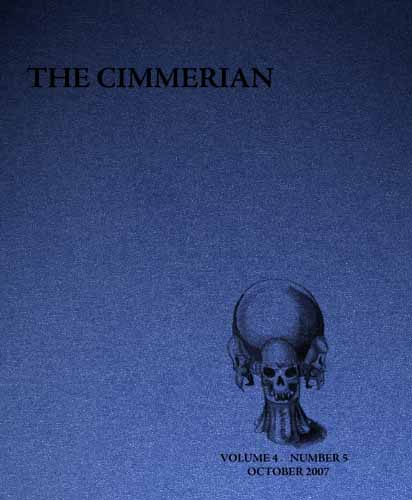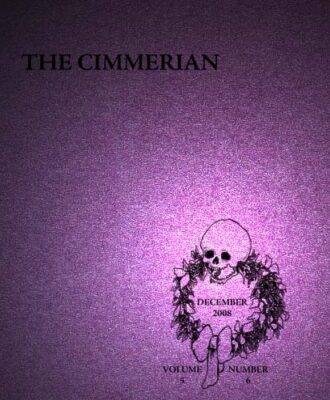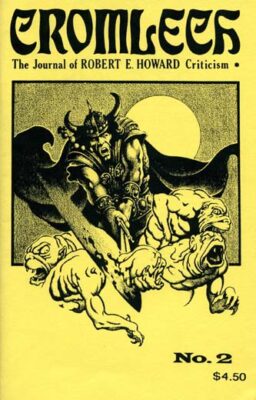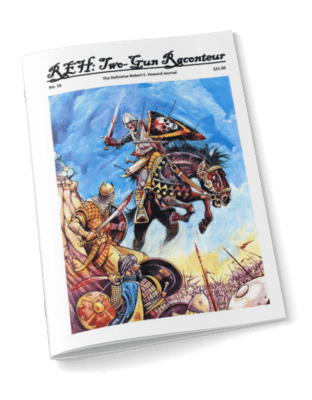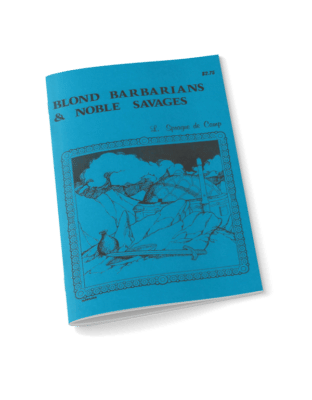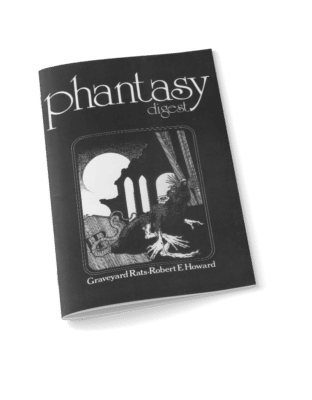Edited by Leo Grin | Illustrated by Andrew Cryer | 40 pages
This issue was printed in two editions. The deluxe edition, numbered 1–75, uses a black linen cover with foil-stamped midnight blue text. The limited edition, numbered 76–225, uses a midnight blue cover with solid black text.
Contents
- “The Haunted Past” by Leo Grin (Editorial)
- “In the Footsteps of Two-Gun and The Kid” by Rob Roehm
- “The Other REH Days” by Bill “Indy” Cavalier
- “Sword-and-Soul” by Steven Tompkins
- “The Gods Rage At Us” by Darrell Schweitzer (poem)
- “Requiescat in Pace: by Robert Jordan, 1948-2007”
- “The Lion’s Den” by Brian Leno, Eric Johnson, Morgan Holmes, Tom Verhaaren, Kevin Cook, Jack Jones, Darrell Schweitzer, Rob Roehm, Steve Trout, Steven Tompkins (letter column)
- Contributors
| Publisher : | Leo Grin |
| Year : | October 2007 |
| Format : | Chapbook ( 6.9 x 8.5, saddle stapled) |
| Pages : | 40 |
| Cover : | Andrew Cryer |
| Illustrations : | Andrew Cryer |
Notes
DELUXE COPIES DESTROYED: 12
LIMITED COPIES DESTROYED: 12
Features a pictorial research trip to the site of another famous Howard photograph, full coverage of the Robert E. Howard Days action at Gen Con 2007, a long substantive interview with one of the best Howard-inspired fantasists, poetry, letters, and more.
Excerpts
It’s notable that, even while he was touting Howard, Gygax often went out of his way to distance his creation from another great fantasist, J.R.R. Tolkien. In Dragon magazine #95 (May 1985), Gary Gygax says, “On the influence of J.R.R. Tolkien on the D&D and AD&D game, a careful examination of the games will quickly reveal that the major influences are Robert E. Howard, L. Sprague de Camp and Fletcher Pratt, Fritz Leiber, Poul Anderson, A. Merritt, and H. P. Lovecraft.”
— from “The Other REH Days” by Bill “Indy” Cavalier
Anger was the bottom line. The reason I started writing the Imaro stories in the first place was that I was so pissed off at the way Africans and blacks in general were portrayed in fantasy and science fiction, and that anger impelled me to do something about it. Call it “literary militancy.”
But anger wasn’t my only fuel. Excitement entered into the mix as well. I knew I was doing something unique; something that hadn’t been done before. That knowledge was a powerful motivator. I didn’t think of it this way then, but I was inventing a new subgenre: Sword-and-Soul.
— Charles R. Saunders, from “Sword-and-Soul” by Steven Tompkins
I was an adult when I finally come across the most egregious of Howard’s Hyborian anachronisms — one which de Camp’s editorial hand had long hidden from me — the blithe introduction of not just gunpowder, but rocketry, into the Hyborian Age. This really set me back on my heels. If gunpowder were known, then bombs and mines would have been a part of the wars of the era. It wouldn’t be a stretch to imagine simple mortars or even cannons wreaking havoc with the armored knights, given the iron-working technology Schweitzer refers to. Not to mention that working rockets would also be used in warfare, rather than just communication.
It is true that in “Black Colossus” Natohk spreads a powder which ignites at the spark of steel-shod hooves, but it is not identified as gunpowder, but as a magic dust of phosphorescent hue. When Darrell gives the caveat “if they have gunpowder” one has to wonder when the last time he actually read the Conan stories was. This story appeared in 1987, and again in 2001 and 2005. No doubt he has never read it, or he would have included this point in his argument.
— Steve Trout, writing in The Lion’s Den


